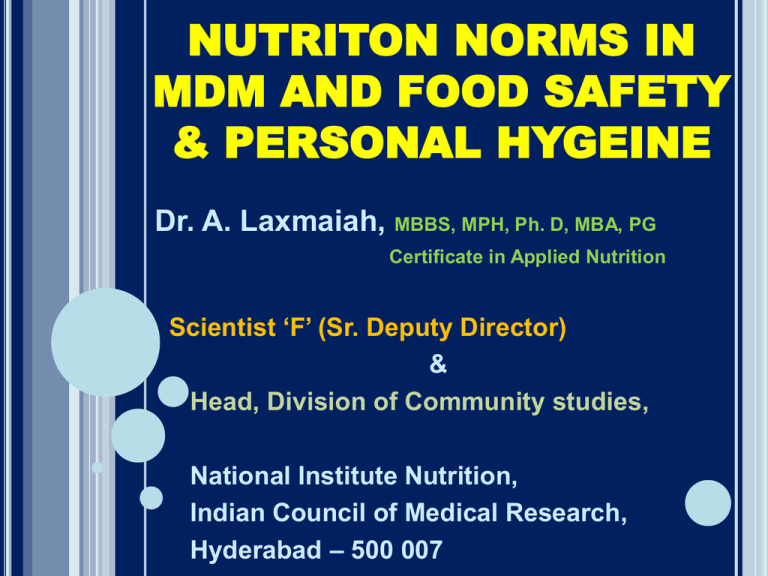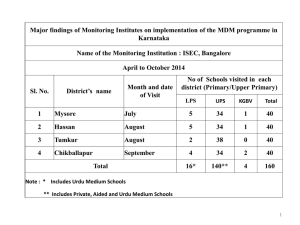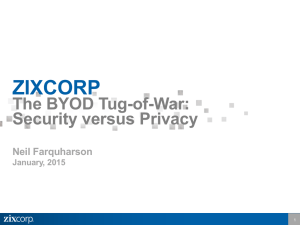Vitamin A
advertisement

NUTRITON NORMS IN MDM AND FOOD SAFETY & PERSONAL HYGEINE Dr. A. Laxmaiah, MBBS, MPH, Ph. D, MBA, PG Certificate in Applied Nutrition Scientist ‘F’ (Sr. Deputy Director) & Head, Division of Community studies, National Institute Nutrition, Indian Council of Medical Research, Hyderabad – 500 007 Regardless of who the Father of a disease is, Surely its Mother is IMPROPER DIET Old Chinese Proverb FOOD AND NUTRIENTS: Why these are required? … Growth Increase in Physical Mass Eg. Weight, Height etc. … Development Functional Capability Eg. Mental, Physiological etc. … Maintenance Body Processes Macronutrients (Required in large amounts and metabolized in the body to provide mainly energy) Proteins Fats Carbohydrates Micronutrients (Required in small amounts, do not supply energy, but important for regulation of metabolism and utilization of macronutrients) Vitamins Minerals By Function - Energy Rich Foods - Body Building Foods - Protective Foods Energy Rich Foods Major Nutrients - Carbohydrates & Fats • Food Stuffs Whole grain cereals and Millets Vegetable oils, ghee & butter Nuts & Oilseeds Sugars • Other Nutrients Protein, fiber, minerals, calcium, iron & B-complex vitamins Fat soluble vitamins, essential fatty acids Proteins, vitamins & minerals Nil Body Building Foods Major Nutrients - Proteins • Food Stuffs Pulses, Nuts & Oilseeds Milk & Milk Products Meat, Fish & Poultry • Other Nutrients B-complex vitamins, invisible fat & fiber Calcium, Vitamin A, Riboflavin & Vitamin B-12 B-complex vitamins, iron, iodine & fat Protective Foods Major Nutrients – Vitamins & Minerals • Food Stuffs • Other Nutrients Green leafy vegetables Antioxidants, fiber & Other carotenoids Other vegetables & fruits Fiber & antioxidants Eggs, milk & milk products and flesh foods Protein & fat Recommended Energy Allowances for Adults Activity level Adult Man Sedentary 2425 (2318) 1875 (1790) Moderate 2875 (2727) 2225 (2106) Heavy 3800 (3485) 2925 (2691) ( ) Proposed 2009-10 Adult Woman RDA for Protein Group Adult Man Adult Woman Pregnant Woman Lactating Woman Infants 0-6 m 6-12 m ( ) Revised 2009-10 RDA (g/day) 60 50 65 (73) 75 (67) (g/Kg) 2.05 (1.23) 1.65 (1.15) Group RDA (g/day) Children 1-3yr 4-6yr 7-9yr 22 (16) 30 (20) 41 (29) Adolescents 13-15 yr- Boys Girls 70 (52) 65 (52) 16-18yr – Boys Girls 78 (60) 63 (58) RDA for Fat Visible Fat Group Adults Adolescents (1318yr) Children (1-9yr) Pregnant Woman Lactating Woman 1989 20 2010 15-20 22 15-20 25 20-25 30 28-33 45 33-38 What is a Balanced Diet? • A balanced diet can be defined as one, which contains the various groups of food stuffs such as energy yielding foods (carbohydrates, fats), body-building foods (protein), and protective foods (vitamins, minerals) in required amounts and proper proportions. So that an individual is assured of obtaining the minimum requirements of all the nutrients for proper maintenance of health and nutritional status. • The components of a balanced diet will differ according to age, gender, physical activity, economic status, occupation and the physiological state like pregnancy, lactation etc. A Good Combination for a Balanced Diet Generally : About 60-70% of calories should come from carbohydrates preferably complex CHO About 10-15% should come from protein. About 20-25% should come from all fats (Of this, a max. of one third may be saturated fat). Poor diet is the 4th biggest global risk factor for disease How diversified is our diet? gaps Intake of cereals and millets high in low income /rural population % DEVIATION FROM SUGGESTED INTAKE MEN, MODERATE ACTIVITY) (ADULT 40 FATS MILK NUTS FRU NVEG. -40 VEG. -20 P&L 0 C&M % DEVIATION 20 -60 -80 NNMB Technical Report No.26, Diet and nutritional status of population -- 2012 Micronutrient deficiency do not occur in isolation but rather concurrently Nutrient Median Intake RDA Iron 12 mg 17 mg Vitamin A 124 µg/CU/d 600 µg Riboflavin 0.8 mg/CU/d 1.4 mg Vitamin C 29 mg/CU/d 40 mg Dietary folate 118 µg/CU/d 200 µg Iodine Iron Zinc Vitamin A Vitamin B12 Folic acid Calcium Vitamin D NNMB Technical Report No. 26, 2012/NFHS Micronutrients (vitamins and minerals) are essential for many functions and health Good Health Normal Brain Growth Normal Growth Strengthening immune system 13 minerals and 14 vitamins that are only needed in small amounts, but are essential for …health Healthy Babies Good Performance They cannot be produced by the body and have to come from the diet Healthy aging Three types of food fortification are in place Conventional fortification • Staple foods (flour, sugar, milk, oil, rice) • Dairy (milk, yoghurt) • Spreads (margarine) • Condiments (salt) Home fortification • Powder • Sachets Bio-fortification • The breeding and genetic modification of plants so as to improve their nutrient content • Agricultural products (rice, maize, sweet potato,…) IRON BIOAVAILABILITY Regular meal was diversified with 100g guava among adolescent girls-boys and iron absorption was estimated for both the meals using stable isotope technique. Diversified with 100 g Guava Fe : AA = 1 : 5 Diversified meal found to increase iron absorption by 2 times among both the girls and boys. Regular Lunch Diversified Lunch Regular Lunch Diversified Lunch Nair et. al 2013, J Nutr; 143: 852-858 RDA and 50 % of RDA for children, adolescents, Pregnant, and Lactating women (2010 RDA ) Micronutrient Average RDA 6months – 6 y Calcium mg Iron mg Iodine µg Zinc mg 600 (450) 9 (15) 100 5 (10) Vitamin A µg 375 Vitamin B2 mg Vitamin C mg Folic acid µg Vitamin B12 µg 0.9 40 90 DFE =54 Folic acid 0.2-1 RDA 50% RDA Pregnant women 300 1000 4.5 38 50 200 2.5 15 187600 200 1. 3 0.5 20 27-30 0.5 Lactating mothers 1000 30 200 15 950 Adolescent s 800 27 120 11 600 1.4 1.4 40 400 40 150 40 90 1 1 1 Values in parenthesis the existing guidelines based on previous RDA for Indians PREVALENCE (%) OF THINNESS (<5th Centile) AMONG 5-17 YEARS BOYS AND GIRLS USING BMI AGE AND GENDER SPECIFIC CENTILES 80 69.6 71.7 Boys Girls 62.8 59.2 Percent 60 40 38.1 40 20 0 5-9yrs 10-13yrs 14-17yrs NNMB Tribal surveys 2008-09 Food Safety and personal hygiene Mostly chronic hunger and starvation persist in large sections of the population, because of un-hygienic preparation, storage, serving and the way we eat. INFECTION AND UNDERNUTRITION ….. a Vicious Cycle INFECTION Reduced Food intake/ absorption Lowered resistance/ Frequent infections Death UNDERNUTRITION Food Safety Food Adulteration Food Contamination Definition of food safety (FAO/WHO, 2003) It is the degree of confidence that food will not cause sickness or harm to the consumer when it is prepared, served and eaten according to its intended use FOOD SAFETY SCENARIO IN INDIA The common man in India understands food safety as “ maintaining personal hygiene, cooking in clean utensils with clean water and serving hot foods“. This is essentially due to the fact that semi processed raw materials are purchased from the market and food is essentially prepared at home. Basic food safety measures are integrated in the cultural habits. Hence food safety in India can be discussed - Food Safety at Household Level - Food Safety at market level (sale places) Food Contaminant Substances that have not been intentionally added to food and present in food as a result of the various stages of its production processing, packaging, transport or holding. Classification of Food Contaminants - Physical - Chemical - Biological Physical contaminants : Hair, bones, sand particles, iron filings, staples pins etc Chemical Contaminants: Pesticide residues Toxic metals Veterinary Drug residues Poly chlorinated biphenyls Dioxins Chemicals formed during processing Biological contaminants: Viruses, Bacteria, Parasites, Shellfish toxins, Mycotoxins Distribution (%) of Households by Sanitary latrine (46,000 HHs in 10 states) Prevalence (%) of Undernutrition (Weight for age) among 1-5 Year Children: By Sanitary latrine p<0.001 Households (%) having safe drinking water (Tap water) in 10 major States of India 90 S. Latrins 84.8 Underweight 80 66.5 70 60.1 56.1 56.1 60 44.3 50 40 54.2 51.8 42.8 48 46.3 37.8 36.5 30 20 51.2 24.1 15 10 13.7 12.7 9 0.9 0 NNMB Rural surveys 2011-12 Food preparation centres Food distribution centres Assessment of :•Sanitation and hygiene of cooking & serving premises •Personal hygiene of food handlers •Food material handling practices Microbiological analysis of cooked food items Microbiological analysis of water Focus Group Discussion for studying consumer acceptability Identification of CCPs for contaminated dishes Data analysis and interpretation TOOLS AND TECHNIQUES ASSESSMENT OF SANITATION AND HYGIENE OF COOKING AND SERVING PREMISES ASSESSMENT OF FOOD MATERIAL HANDLING PRACTICES ASSESSMENT OF PERSONAL HYGIENE OF FOOD HANDLERS Observation checklist Interview schedules Microbiological analysis A three point scale was used for scoring the qualitative parameters. MICROBIOLOGICAL ANALYSIS Food samples Water samples Hands, equipment, utensils and surfaces samples • Microbiological analysis included Total plate count (TPC) Coliform count Microorganisms like E. coli, Coagulase positive staphylococci Bacillus cereus in cereal preparations and Yeast and mould count for the sweets • Standard BIS methods should be followed RESULTS AND DISCUSSION FOOD RECEIVING FOOD ASSEMBLY STORAGE PREMISES WORKING AREAS WASHING COOKING PREPREPARATION Space dryness, Cleanliness, lighting and ventilation Personal Hygiene of Food Handlers 27 % 18 % 91 % Microbiological analysis for surface sanitation revealed Hands, surfaces, equipment and utensils were contaminated with pathogens Microbiological quality of water Distribution Centers Total Plate Coliform/100 Fecal E.coli Count ml Coliform /100 ml (cfu/ml) /100 ml 1 1 x 101 9 - - 2 3 1.7 x 102 1.7 x 102 1600 > 1800 + + + - 4 5 1.2 x 102 ND 12 27 - - ND-(< 1 cfu/ml) Coliform has been estimated using MPN tubes Food analysis - Daily Menu of the meal Cereal Preparation Pulse Preparation Vegetable Preparation Sweet Preparation + / / / / / / Foods in which pathogenic microorganisms seen (food distribution centers) Rice Aloo Sabzi Coliform count Coagulase positive staphylococci count Rice, Chole and Aloo sabzi, Kadhi, kheer, halwa, puri, Rajma, Parantha Chole/chane E. Coli Dal and chapatti Standards used:- IFSA and AEA, 2007 Identification of CCP’s - Microbiological analysis of Rice Raw rice Washing of Rice Cooking of rice in utensil Straining through colander Filled in steel drums Identification of CCP’s-Microbiological analysis of Sabzi at each stage of production Raw Potatoes Raw Onions Soya bean Peel Peel Wash Wash Wash Soak in water Cut Cut Wash Cooking in the utensil Transferred to steel drums Objective:- Effect of washing on microbial load of vegetables Method:1.Washing was done with 3L water/kg of vegetable in a big container 2.Washed three times with peel to remove dirt and again without peel 3.Washing was done till dirt removal was assured visually. 4.At each step vegetable sample was taken and analyzed microbiologically Results:1. Raw vegetables had a high microbial load and pathogens 2. After peeling microbial load was slightly reduced but E.coli was detectable 3. After final washing total load was reduced and pathogens were absent 4. After repeated washings, dirt/filth had been removed and when METHOD FOR PREVENTION OF CONTAMINATED DISEASES SIX STEPS IN WASHING Summary and Recommendations SOP should be followed for in cleaning of equipment & utensils, surfaces. Continuous education and training programme is necessary Care may be taken in food material handling Ensure personal hygiene to avoid contamination MDM NUTRITION NORMS PROTEIN AND CALORIE ADEQUACY STATUS (P+ C+) BY AGE GROUP-GAPS 10-12 State 1-3 4-6 13-15 16-17 7-9 B G B G B G Men Women Kerala 13.9 13.9 13.6 7.3 12.2 11.9 14.3 16.2 25.4 53.0 60.0 Tamil Nadu 20.4 9.2 6.8 7.0 8.9 8.7 19.4 21.6 60.5 59.8 76.9 Karnataka 34.3 18.2 26.7 22.7 17.4 23.5 28.6 38.9 38.1 59.1 79.4 A.P 41.3 46.3 47.2 34.2 50.8 44.3 47.7 60.7 66.1 72.8 76.3 Maharashtra 36.0 41.8 47.1 42.4 48.4 49.4 50.3 60.9 67.6 65.6 72.8 Gujarat 54.7 42.6 46.8 32.9 47.3 26.5 44.6 36.7 72.1 65.6 86.3 M.P 22.7 19.8 21.3 14.8 16.6 16.5 16.4 21.3 50.0 36.5 62.2 Orissa 24.6 14.5 17.2 18.2 26.9 27.0 57.9 59.8 80.2 83.2 89.3 W Bengal 34.9 57.5 53.3 57.1 66.0 74.5 64.1 63.0 65.0 82.4 82.1 Pooled 30.1 29.4 31.5 25.6 32.8 30.7 38.9 44.2 61.0 65.2 73.2 NNMB Tribal surveys 2008-09 Nutritional Norms in MDM Nutritional Content Norm as per NPNSPE, 2004 Revised Norm as per NPNSPE, 2006 Calories 300 450 Protein 8-12 12 Micronutrients Not prescribed Adequate quantities of micronutrients like iron, folic acid, vitamin-A etc Average intake of Food stuffs by school children in MDM (g/student/day): Institutional diet survey Primary Children Food Stuffs Upper Primary Children MDM Norms Actual Intake MDM Norms Actual Intake (g) (g) (g) (g) Cereals (Rice) 100 76 150 93.5 Pulses (lentils, soya, Bengal gram) 20 18 30 15.8 Fat & Oils (Mustard Oil) 5 4.1 7.5 4.3 Vegetables 50 7.8 75 19.3 MDM: Punjab Free folic Acid (µg) Vitamin C (mg) Niacin (mg) Riboflavin (mg) Thiamin (mg) Vitamin A (µg) Iron (mg) Calcium (mg) Fat (g) Energy (K cal) Proteins (g) Particulars Average intake of Nutrients (per/day) through MDM Primary School children Through MDM Regular Diet * ICMR RDI 10.7 402 6 62.3 2.8 15.4 0.2 0.1 2.64 2.9 31.5 31 1248 12 159 7.0 59 0.7 0.3 9.1 15 33 41 1950 22 400 26 600 1.0 1.2 13 40 60 Upper Primary School children Through MDM Regular 11.0 448 6 75.7 2.3 10.7 0.2 0.1 1.8 23.2 9.9 35.1 1387 12.4 172 8.1 63 0.8 0.4 10.1 15.7 36.5 55.0 2080 600 26.5 600 1.05 1.25 14 40 70 diet* ICMR RDI 24 * NNMB Tribal study 2008-09 Free folic Acid (µg) Vitamin C (mg) Niacin (mg) Riboflavin (mg) Thiamin (mg) Vitamin A (µg) Iron (mg) Calcium (mg) Fat (g) Energy (K cal) Proteins (g) Particulars Average intake of Nutrients (per/day) through MDM Institutional Level Primary 10.7 402 6 62.3 2.8 15.4 0.2 0.10 2.64 2.9 31.5 Upper primary 11.0 448 6 75.7 2.3 10.7 0.2 0.1 1.8 23.2 9.9 Nutritional Fategharh Sahib Ludhiana Pooled 1.1 1.5 1.3 0 0.5 0.2 Angular Stomatitis 0.9 0.5 0.7 Phrynoderma 0.6 0 0.3 Dental Caries 14.2 16.1 15.1 Dental Flurosis 2.0 0.3 1.2 Goitre I (palpable) 0.5 0.2 0.3 deficiency signs Conjunctival Xerosis Bitot spots Punjab – school children Impact of MDM Programme: Karnataka (contd.) Wt/Age % of NCHS Stds Grade IV (< 60) MDM Non - MDM 18.5 20.8 Grade III (60-69.9) 40.0 41.5 Grade II (70-79.9) 28.8 26.6 Grade I (80-89.9) 9.7 9.8 Normal (> 90) 3.0 1.3 Laxmaiah et al 1999 Impact of MDM Programme: AP Wt/Age % of NCHS Stds Grade IV (< 60) MDM Non - MDM 11.4 15.4 Grade III (60-69.9) 33.3 37.0 Grade II (70-79.9) 37.7 33.3 Grade I (80-89.9) 14.9 11.5 Normal (> 90) 2.7 2.8 Sarma KVR et al, Asia Pac J 1995; 8 (1): 48-52 Effect of Regularity of MDM Programme Variables - No. of Feeding days < 90 90 Retention Rate - 46.3 56.2* Drop out Rate - 29.7 23.5* 11.4 15.4 2.8 2.7 % Normal 61.0 59.0 % Stunted 26.0 27.5 % Wasted 9.3 10.0 % Wasted & stunted 3.7 3.5 Weight foe Age < 60 (% NCHS Std.) 90 Waterlow Classification P < 0.01 Sarma KVR et al, Asia Pac J 1995; 8 (1): 48-52 Changes observed in their children as beneficiary of MDM (Multiple responses) Suggestions to strengthen the MDM Hygiene practices of school children Hand washing pracice before takink the food 48.6 Washing of plates and glassess 100 Hand wash after defecation 59.5 Brushing teath with brush 37.8 Regular nail cutting 89.2 Daily bathing 18.9 0 20 40 60 80 100 120 Knowledge about the objectives of MDM programme: Functionaries BEST PRACTICES E-transfer of funds at all levels. RTGS no. of majority all bank accounts of schools. Kitchen Garden Strong Grievance redressal mechanism. Rigourous monitoring system - Samikshya Idea box Kitchen gardens Student helpline number Additional Water Point Ministry of HRD, Govt of India Dining Hall at MS Jagarnathpur Children eat Mid day Meal in Dining Hall Force & Lift Pump THANK YOU







